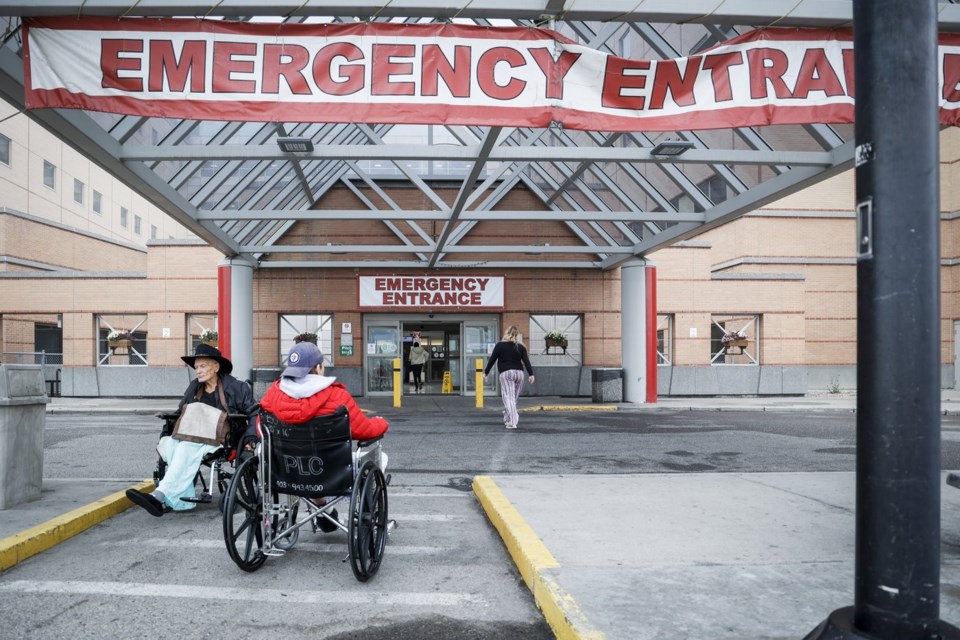EDMONTON — The head of emergency medicine for Alberta's doctors association is challenging Premier Danielle Smith to join him on shift to see the frustration of patients jammed for hours in hallways and the moral injury of doctors looking into the eyes of the those who wait.
“It's this kind of vicarious trauma, this inability to help when we're helpers, that is causing us to leave,” Dr. Warren Thirsk said in an interview.
“Unless you experience it, you don't really get it.
“When the premier has a health emergency, do you think she's going to sit in my waiting room and wait 13 hours to be seen?
“I would challenge her to come and sit in my waiting room for 13 hours.”
Thirsk made the comments in the wake of a new survey measuring patients' experiences released late last week by the Alberta Medical Association, which represents the province’s physicians.
Thirsk is the association's head of emergency medicine and works in the emergency ward of Edmonton’s downtown Royal Alexandra Hospital.
He said when he arrived for a recent 6 a.m. shift, the hallway was already full of patients brought in by ambulance the night before. Some had been waiting 14 hours.
He remembers one patient with a broken hip had been there four hours and needed an operation.
This one had to be treated first. “When I looked after that patient in the hallway with a broken hip, I had to stare into the eyes of the other 13 people down that hallway who all watched me walk up to one person and not them," Thirsk said.
“I have the haunted stares of every other person who's looking at me, saying, ‘Why aren't you in front (helping) me?'”
The hip patient was seen and admitted into the hospital, he said, but then had to wait another six hours in the hallway before being moved.
Thirsk said he's seeing a trend of increasing wait times in a system that can't keep up with a provincial population now close to five million. He said he is also seeing frustration, with patients finally giving up the emergency room wait and walking out the door, potentially making their condition worse.
"They might come back the next day, or they come back by ambulance, even sicker,” he said.
The association's survey was taken by just over 1,100 Albertans. It cannot be assigned a margin of error because online surveys are not considered random samples. The survey suggests that in the last year, almost one in five patients waiting for emergency care gave up the wait and walked out instead.
Dr. Shelley Duggan, the association's president, labelled the numbers “disturbing” and attributed them to many factors: lack of specialists; patients left in hospital because of no room in continuing care; and not enough family doctors.
“It's a very complex issue - it's not just one simple fix,” Duggan said in an interview.
Duggan said their survey reflects national challenges that aren’t unique to Alberta, and although most patients are satisfied with their care when they can get it, access here remains a "huge problem."
The Alberta government disputes the survey's numbers, saying they don’t reflect broader health data. The province says the percentage of those leaving the ER without being seen is around 10 per cent in Alberta’s top 16 hospitals.
Kyle Warner, press secretary to Hospital Services Minister Matt Jones, said only two hospitals saw one in five patients leaving the ER early.
“Delays in Alberta’s ED are shorter than in other large provinces and we are one of the top performers in the country — but that’s still not good enough," Warner said in an emailed statement. “We know there is more work to do, and we continue to focus on recruitment.”
Numbers published by Health Quality Alberta, the agency that gathers data for the province, show the number of people who leave before being seen varies depending on the hospital. At Royal Alexandra Hospital, it was as high as almost 22 per cent per cent of patients last fall. At Foothills Medical Centre in Calgary, the average was eight per cent.
But across the board, that number has crept higher than it was in 2020, even in medium-sized urban hospitals like Northern Lights Regional in Fort McMurray, where the average was 5.6 per cent late last year.
NDP Opposition health critic Sarah Hoffman said in a statement it’s unacceptable that so many Albertans are without a family doctor and that emergency room wait times remain dangerously high.
"Despite a promise to improve the system, Danielle Smith’s UCP government has only deepened the chaos," said Hoffman.
This report by The Canadian Press was first published July 7, 2025.
Lisa Johnson, The Canadian Press



